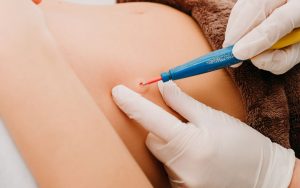Have you ever spotted small, soft growths on your skin, resembling tiny tags hanging off the surface? Or perhaps you’ve struggled with stubborn warts that refuse to disappear? These common skin issues, while usually harmless, can be unsightly or uncomfortable, especially when they appear in noticeable areas like your neck, face, or hands. If you’ve been dealing with these annoying growths, you’re not alone—and the good news is that there’s a straightforward and effective treatment option: cryotherapy.
In this blog, we’ll explore how cryotherapy can help you eliminate warts, skin tags, and other benign skin lesions quickly and effectively. We’ll explain how the treatment works, what to expect during and after the procedure, and why it’s becoming a popular choice for those wanting to remove skin imperfections. If you’re fed up with these bothersome growths, keep reading to find out if cryotherapy is the right solution for you.
What is Cryotherapy?
Cryotherapy is a medical procedure that utilizes extreme colds to treat various skin conditions. The term comes from the Greek word “cryo,” meaning cold, and “therapy,” meaning treatment. In skin care, cryotherapy involves applying liquid nitrogen to freeze and destroy abnormal skin cells, such as warts and skin tags.
Liquid nitrogen is extremely cold, with temperatures dropping as low as -196°C (-320°F). When applied to the skin, this freezing effect causes the targeted tissue to die off, allowing the body to shed it over time naturally. This method is particularly effective for skin tags, warts, and other benign growths that you want to remove without resorting to surgery or more invasive treatments.
How Does Cryotherapy Work for Skin Conditions?
Let’s take a closer look at how cryotherapy works, step by step:
1. Preparation: Before the procedure, your healthcare provider will assess the growth (whether it’s a wart, skin tag, or lesion) to determine if cryotherapy is the appropriate treatment for you. If the growth appears suspicious or if other methods might be more effective, your doctor may recommend a different approach.
2. Application of Liquid Nitrogen: During the procedure, the doctor will apply liquid nitrogen to the growth using either a spray or a cotton swab. This freezing agent acts quickly to freeze the water in the skin cells, leading to their destruction. You’ll likely experience a sharp, cold sensation during this process, which lasts only a few seconds.
3. Tissue Destruction: As the liquid nitrogen works to destroy the skin cells, the tissue in the treated area starts to break down. In the following days, you’ll notice that the area becomes red, and swollen, and may develop blisters. This is a normal part of the healing process as your body eliminates the dead skin cells.
4. Healing and Recovery: After the procedure, the treated skin will begin to heal. A scab usually forms over the area within a couple of days. It’s crucial to avoid picking at this scab, as it protects the new skin underneath. For a week to ten days, the scab will naturally fall off, revealing smooth, healthy skin.
What to Expect During and After Cryotherapy?
However, it’s quite normal for the treated area to appear and feel worse before it improves. Right after cryotherapy, the area may be red, swollen, and possibly a bit painful or itchy as it thaws. In the next couple of days, you might also see some blistering as your skin heals. Don’t worry—this is all part of your body’s natural healing process.
Cryotherapy is a relatively quick and straightforward procedure, typically taking just a few minutes for each skin tag or wart. One of the advantages of this treatment is that it’s minimally invasive, resulting in little to no downtime afterwards.
Within 2-3 days, a scab will likely form over the treated area, remaining for about 7-10 days before it falls off naturally. After the scab has come off, you’ll notice a pink, smooth patch of skin that will continue to heal and gradually blend in with the surrounding skin.
Benefits of Cryotherapy for Skin Tags and Warts
Curious about why cryotherapy could be the right option for you? Here are some of the main advantages:
1. Non-Invasive: Unlike surgical methods, cryotherapy doesn’t involve cutting or stitching, resulting in less pain and minimal scarring.
2. Quick Procedure: Most cryotherapy sessions last only a few minutes, making it a convenient choice for those with busy lives.
3. Effective for Various Skin Conditions: Cryotherapy is not limited to skin tags; it can also effectively treat warts, certain benign lesions, and even precancerous spots like actinic keratosis.
4. Minimal Downtime: While you might experience some redness, swelling, or blistering, the recovery period is generally short, allowing you to resume your normal activities quickly.
5. High Success Rate: Cryotherapy is very effective, especially for smaller skin tags and warts. Often, a single session is sufficient to eliminate the growth.
Are There Any Risks or Side Effects?
As with any medical treatment, cryotherapy carries some risks, though they are usually minor. The most common side effects include redness, swelling, blistering, and discomfort in the treated area. These symptoms typically resolve on their own within about a week.
In rare instances, some individuals may notice changes in pigmentation, where the skin may become lighter or darker in the treated area. This is more prevalent among those with darker skin tones. If you have concerns about scarring or pigmentation changes, be sure to discuss these potential risks with your doctor before the procedure.
Is Cryotherapy Right for You?
Cryotherapy can be an excellent choice for individuals seeking to eliminate skin tags, warts, or benign lesions without resorting to more invasive procedures. It’s a fast and effective treatment that requires little recovery time, making it a favoured option for many. However, it’s wise to consult your healthcare provider to see if this treatment suits your skin condition.
If you have several skin tags or warts, your doctor might suggest multiple sessions to treat all growths effectively. Remember that some individuals may require additional treatments if the initial session doesn’t fully remove the growth.
Take the Next Step
If you’ve been struggling with skin tags, warts, or other unwanted skin growths, now is an ideal time to consider cryotherapy as a solution. Whether you’re fed up with the irritation or simply seeking a cosmetic enhancement, this non-invasive treatment could be just what you need. Why continue to live with those annoying growths when there’s a quick and straightforward way to eliminate them?
Are you ready to move toward smoother, clearer skin? Schedule a consultation with your healthcare provider today to determine if cryotherapy is the right choice.











